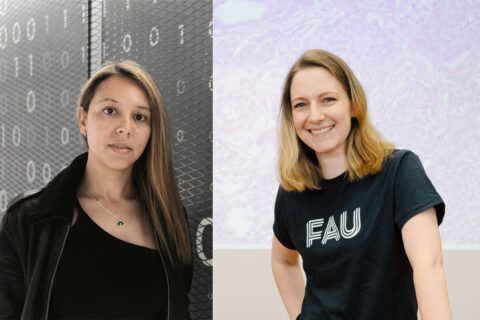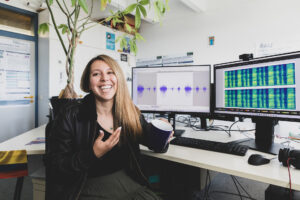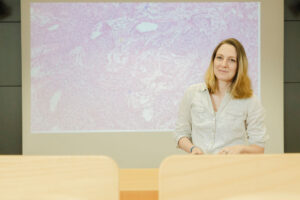Patterns for success
How AI can help predict diseases and find the best treatment options
Katharina Breininger works with image data, Paula Andrea Pérez-Toro with audio signals. Both are investigating how AI can help to predict illnesses, make surgery more tolerable, and find the best treatment options.
When you think about medical progress, data processing is rarely the first thing to spring to mind. However, machine learning can help to improve operations’ chances of success, assess cancer cases more accurately or accelerate complex diagnoses using magnetic resonance imaging. These are just a few of the areas where artificial intelligence can be used in medicine.
Language gives an indication of a later illness
Paula Andrea Pérez-Toro is a computer scientist at the Pattern Recognition Lab at FAU. Her research includes emotions in children, but her focus is on early indications of currently incurable diseases in which ever increasing numbers of nerve cells in the brain cease to function correctly as the disease progresses. The most common of these is Alzheimer’s disease, which severely affects the mental capacities of elderly patients. In second place is Parkinson’s disease with its severe movement disorders, which usually also affects the elderly.
In a remote area of Colombia however, high numbers of people start to suffer from such brain damage in middle age. They start showing symptoms of Alzheimer’s in their thirties already, and by their forties they display significant impairments in their mental faculties. The cause is a single seemingly insignificant mutation in the genes of those affected, that has probably been spreading in a sparsely populated mountainous area in the Departamento de Antioquia since the early 1800’s.
As mutations such as this can be easily identified nowadays, the initial symptoms can be detected at an extremely early stage, where they would normally remain undiscovered in people without the mutation. The Universidad de Antioquia (UdeA), the oldest university in Colombia, is therefore an important center for Alzheimer’s research.
In September 2019, Paula Andrea Pérez-Toro came to FAU for six months on a research scholarship while writing her Master’s thesis at UdeA. Immediately before she was due to return, the Covid-19 pandemic hit, and Colombia closed its borders. Paula Andrea remained at the Pattern Recognition Lab at FAU. Using machine learning, she tracked down changes in language that become apparent before patients present with the first typical symptoms of Alzheimer’s. “Sufferers not only speak in a more monotonous fashion, they also pause longer between words,” explains the young computer scientist. “AI is capable of recognizing deviating patterns like this in audio signals.” However, a lot of research is still required until results such as these will actually benefit patients, explains Pérez-Toro. However, she has opened the door to further research and has also already started using machine learning to treat Parkinson’s disease more effectively and from an earlier stage.
“Mapping” blood vessels during surgery
Chance also had an important role to play in the academic career of Katharina Breininger. The computer scientist arrived at the right place at just the right time. After completing her Bachelor’s degree in Marburg, she changed to FAU for her Master’s: “One of the reasons was because I was extremely interested in medical imaging, and Erlangen is a major center for research in this field,” she remembers. “When I began my doctoral degree in 2015, neural networks were just starting a make a breakthrough in our area.”
In her doctoral thesis, Breininger focused on how machine learning could be used to assist minimally invasive surgery for treating dangerous aneurysms in the aorta. These are bulges in the the aorta that can tear and lead to severe, life-threatening bleeding. For the necessary surgery, patients are given a contrast agent containing iodine that makes blood vessels visible on x-rays. This allows the operating team to observe the blood vessels they are working on in real time.
Contrast agents containing iodine can trigger allergic reactions, however. Katharina Breininger developed algorithms that can be used to reduce these side effects. Images of the blood vessels created before the surgery are adjusted dynamically and are superimposed with the intraoperative x-ray images during surgery, thus allowing them to be used for orientation purposes, almost like a map. “This speeds up the surgery and less contrast agent is required,” she explains. “At the same time, it reduces exposure to x-rays.”
In the meantime, Katharina Breininger and her team have automated the analysis of microscopic images and other image data using artificial intelligence. They hope to characterize tumor cells in breast cancer more accurately than has been the case to date in order to be able to come to a more reliable conclusion about which treatment option is most promising. The group also intends using automatic image processing to investigate the role of certain immune cells, known as macrophages, in inflammatory diseases such as rheumatism in order to identify new approaches for treatment and allow new medicines to be developed. That apart, the team intends working together with other research groups to combine various imaging processes in order to be able to diagnose breast cancer, Parkinson’s disease or kidney disease more accurately.
by Roland Knauer
Profile Center Medical Engineering (FAU MT)
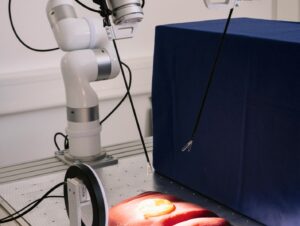
In view of demographic developments, medical engineering is of the utmost relevance to society. It can make a decisive contribution to extending life expectancy, improving quality of life and optimizing cost structures in healthcare. Nearly all faculties at FAU and Universitätsklinikum Erlangen work together closely in the key research priority of medical engineering. The Profile Center pools these activities and coordinates advisory services regarding funding and entrepreneurship, networking events and designing degree programs.
This article is part of the FAU Magazin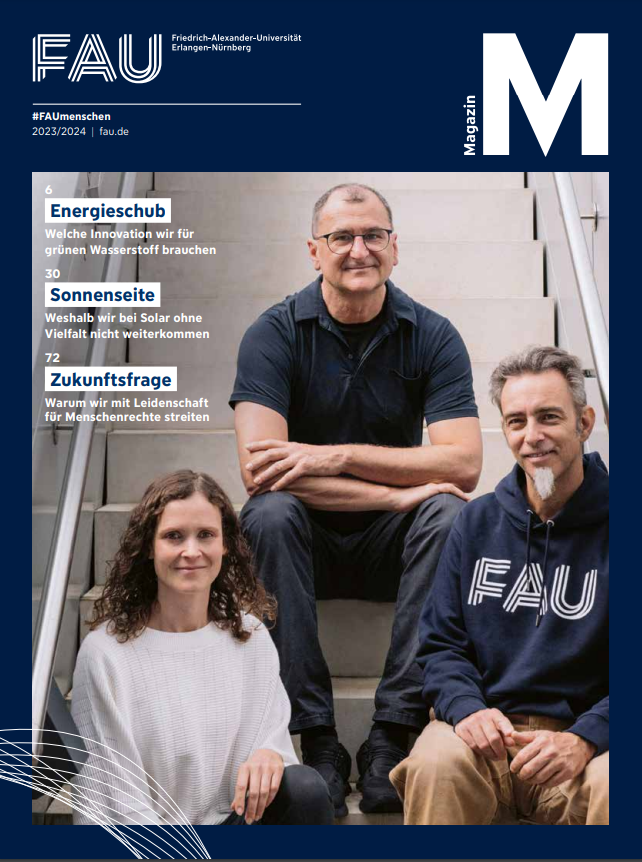
A university thrives because of the people who research, study, teach and work there. A university is supported by people who are connected to it as alumni, friends and sponsors and who are committed to promoting its interests all over the world.
They all contribute their unique talents, skills and perspectives. It is this diversity that makes our FAU a place of innovation, a place where many talented individuals tackle the major challenges of our times together, and a place where they keep finding answers.
Read more articles online Download: FAU Magazin (PDF)
